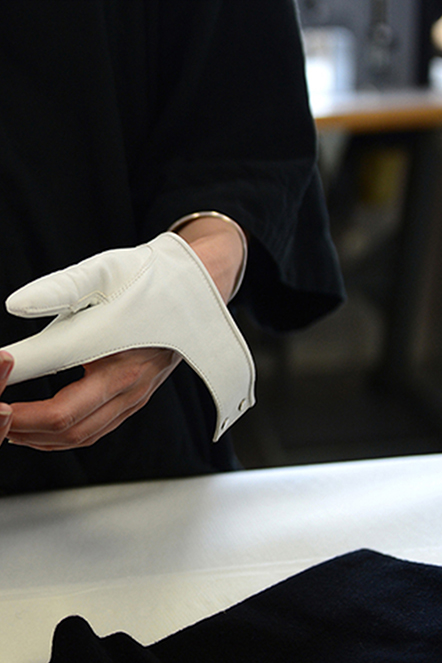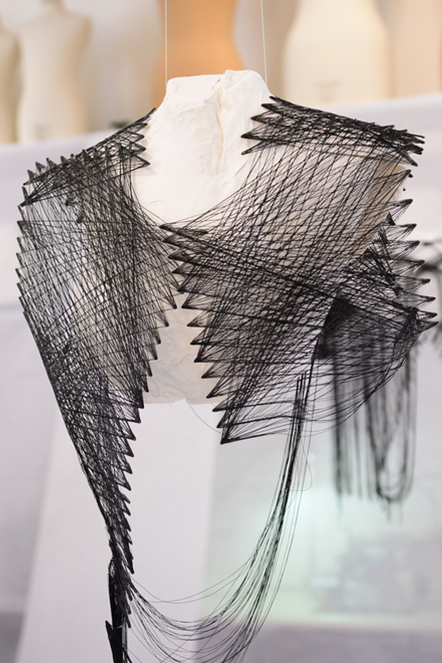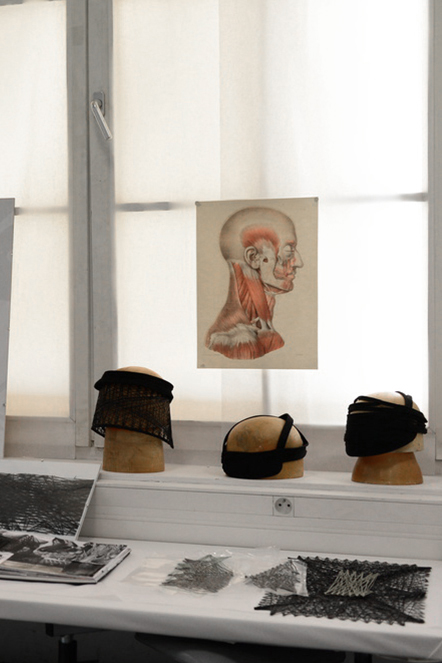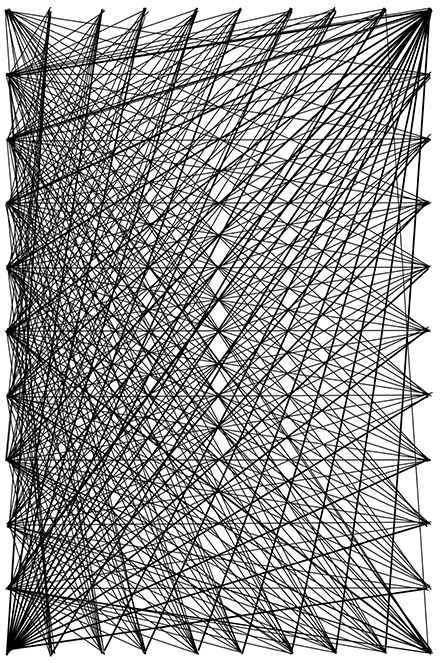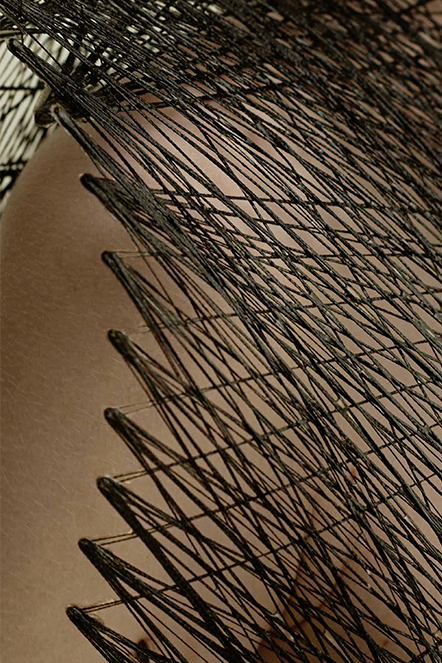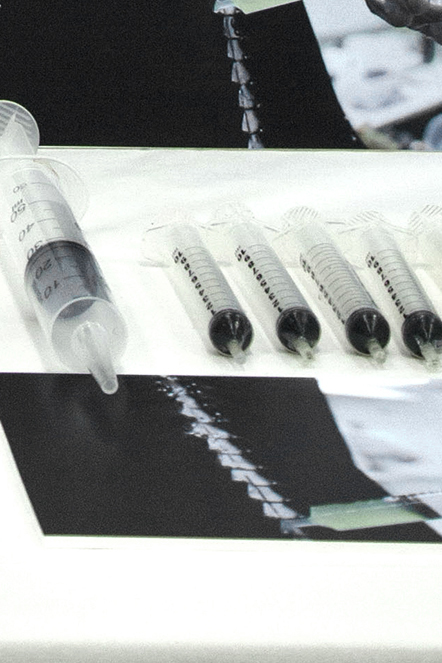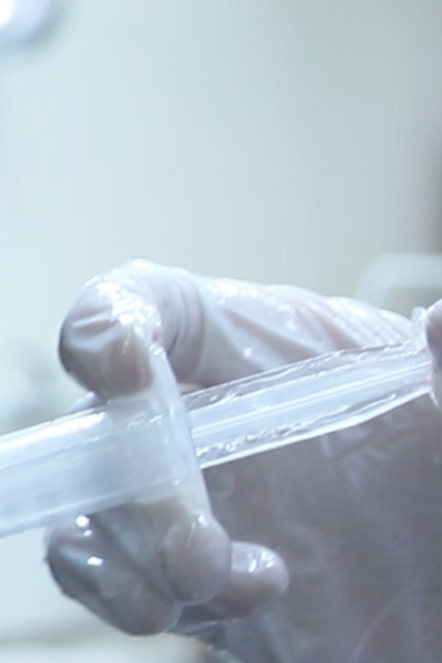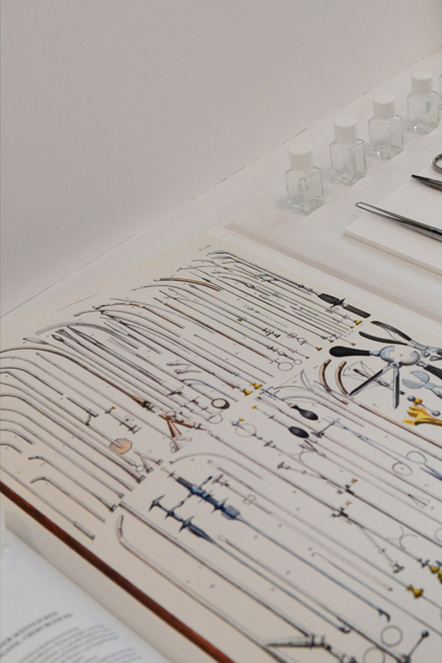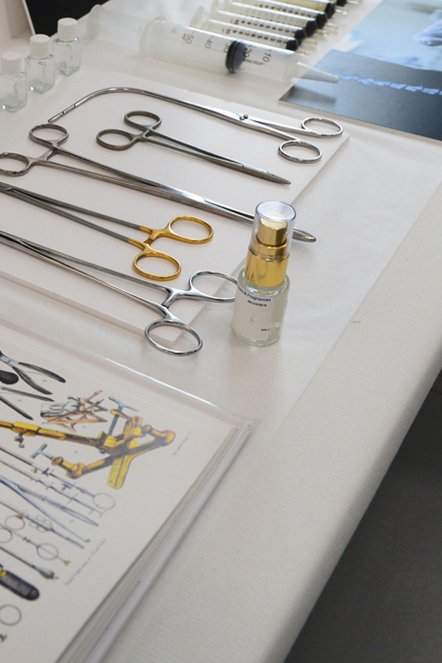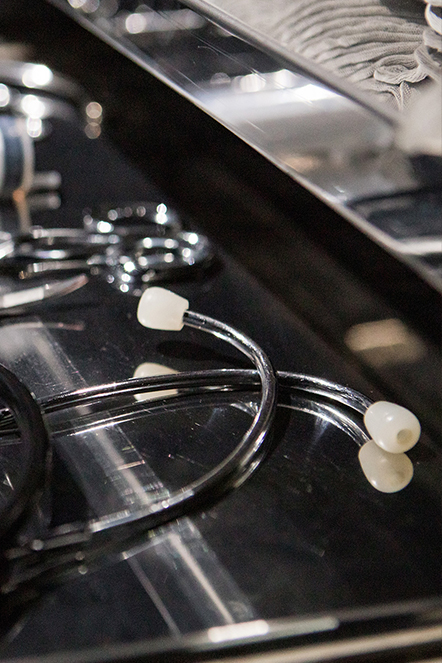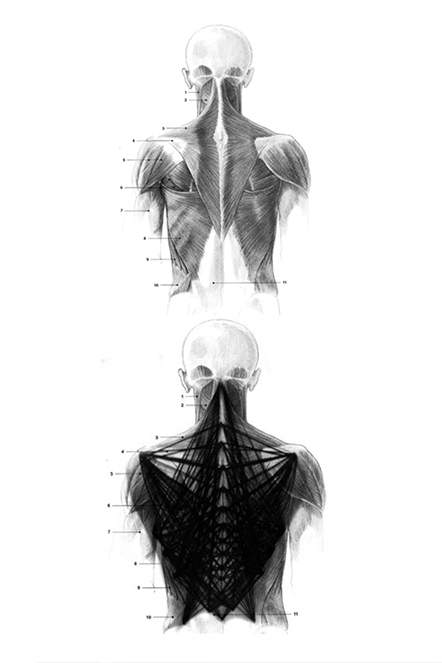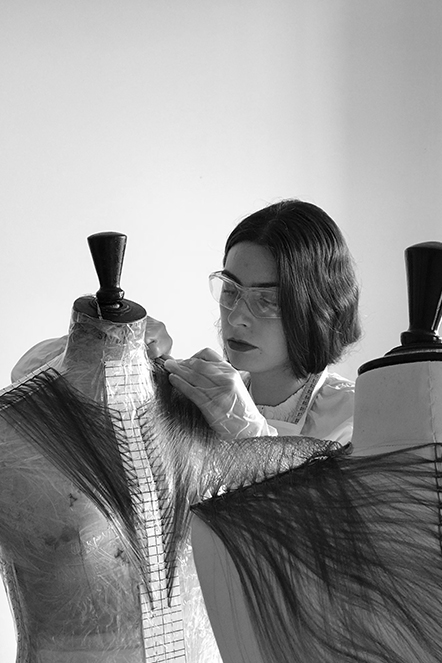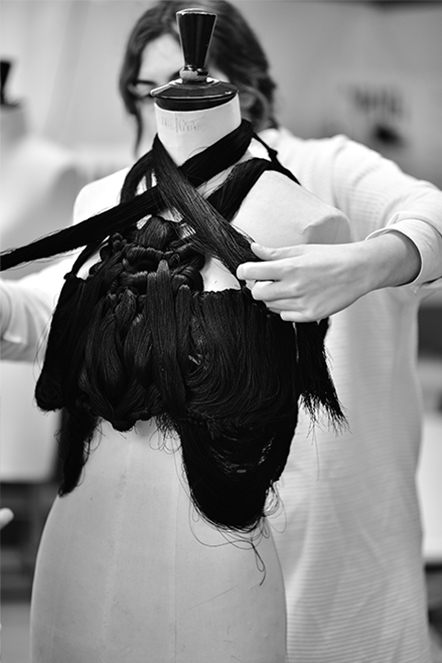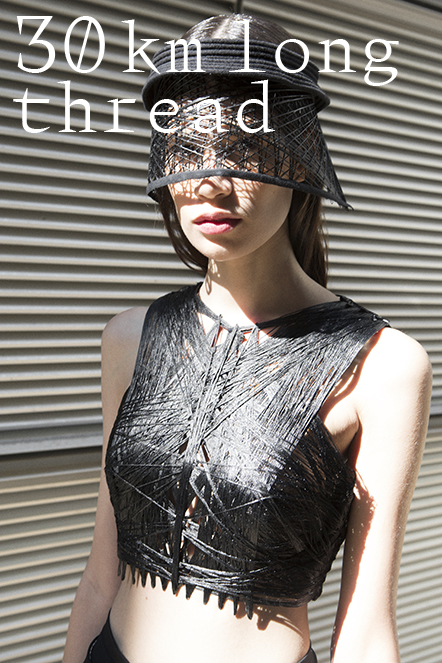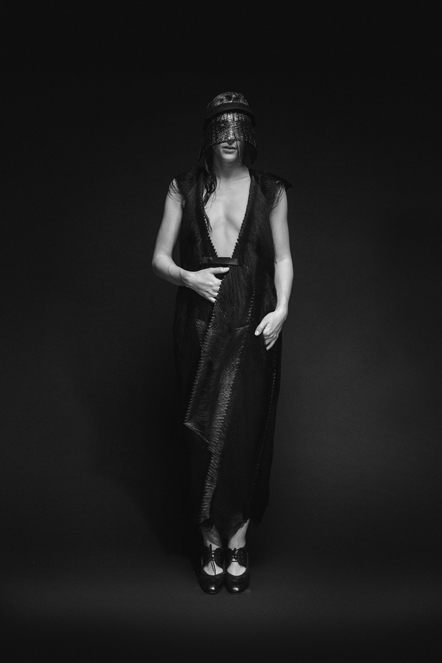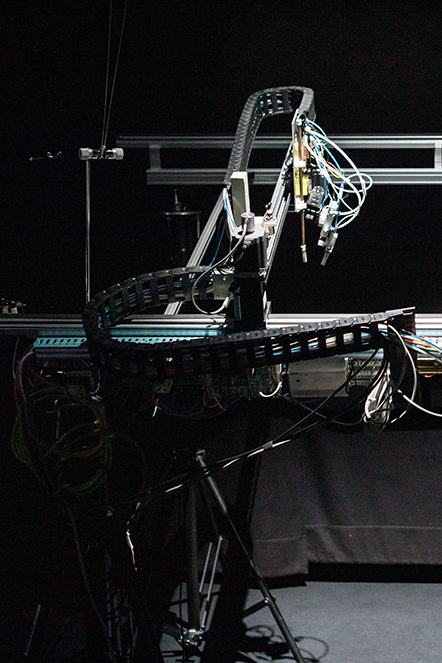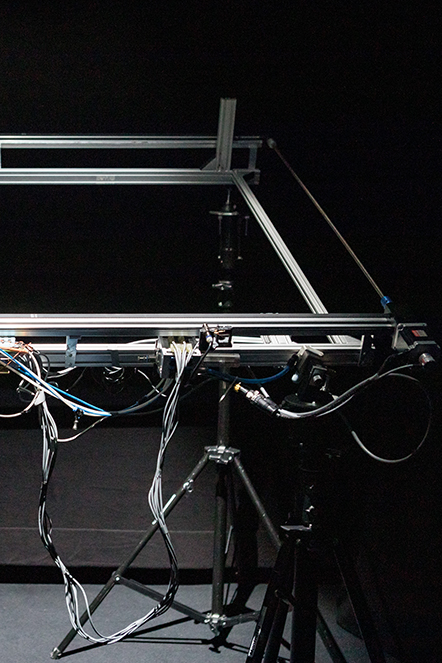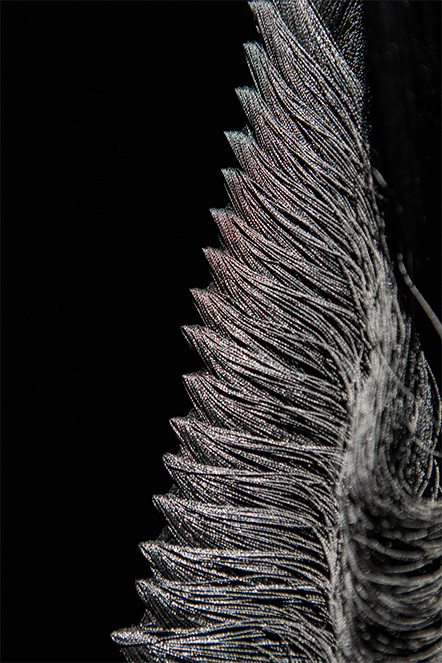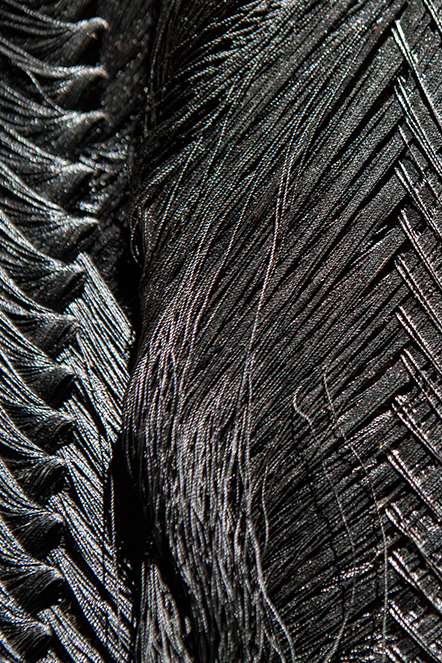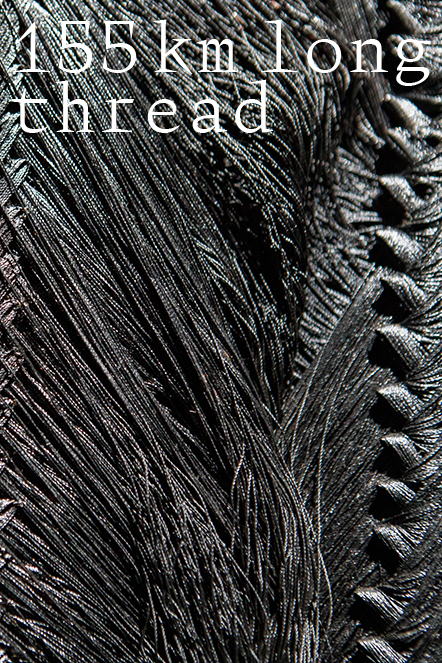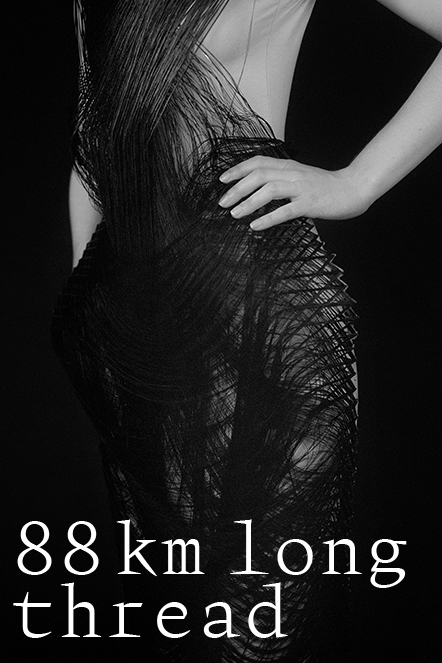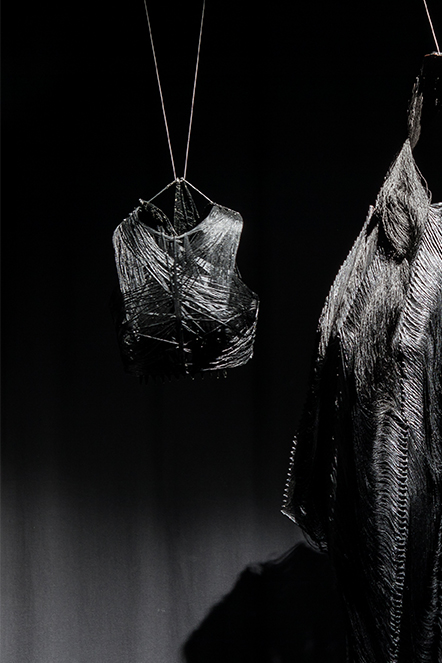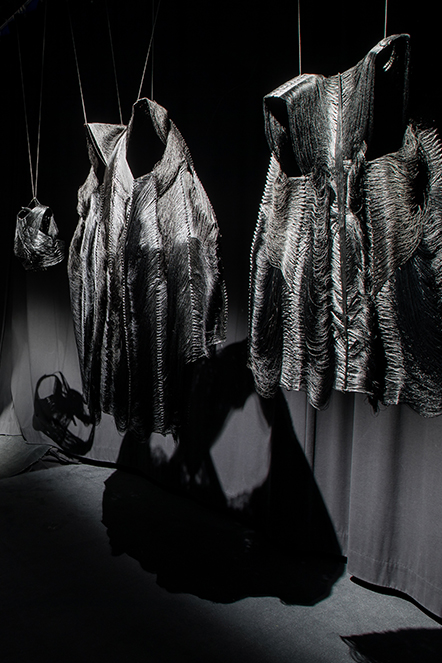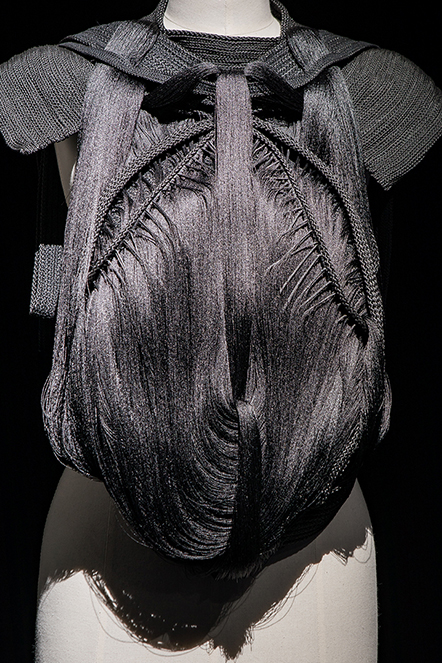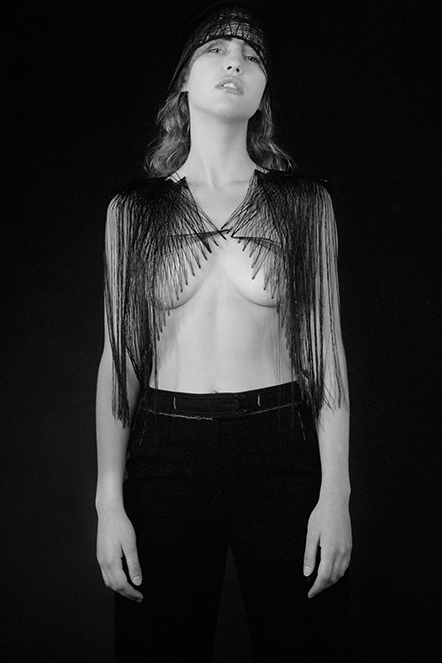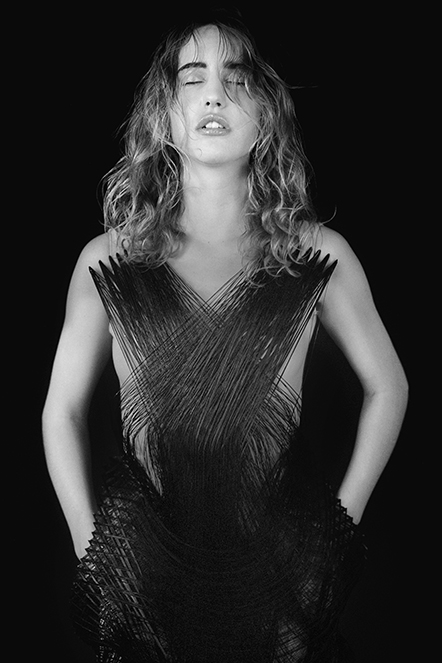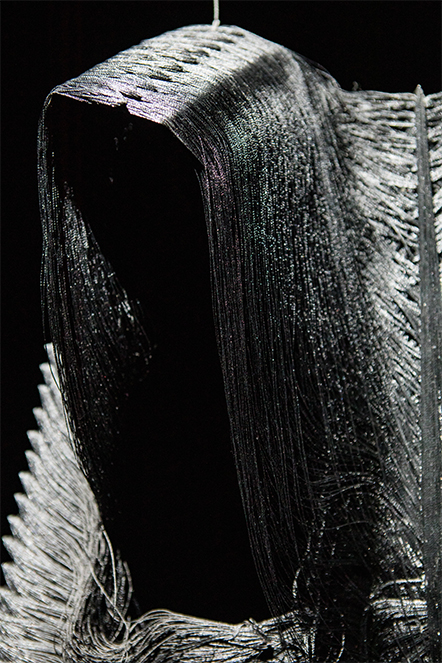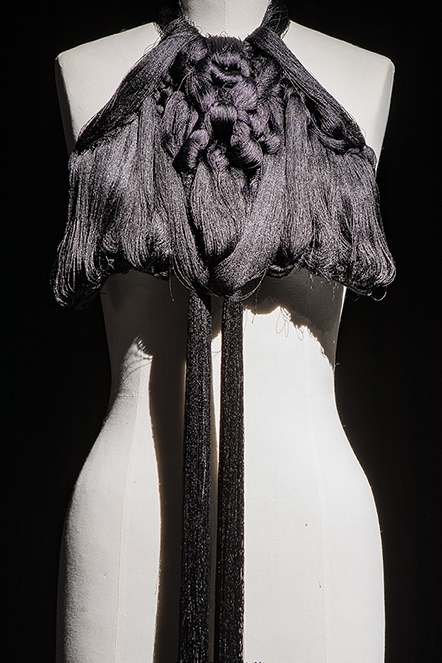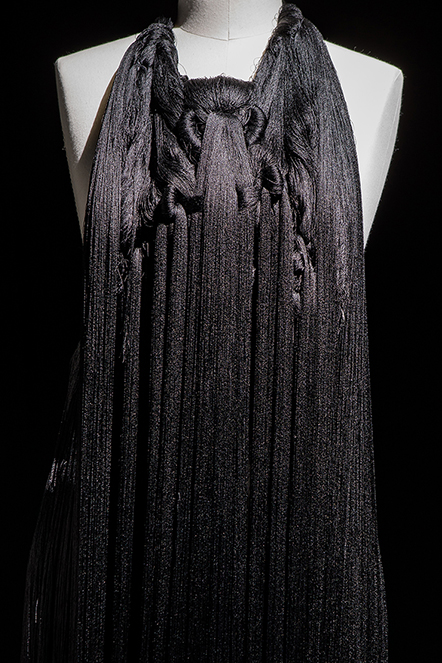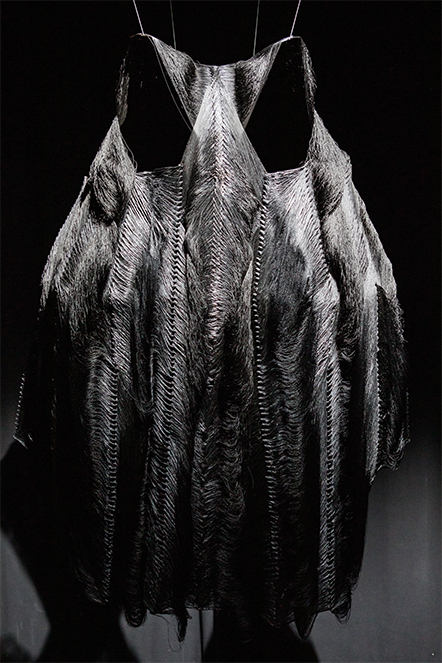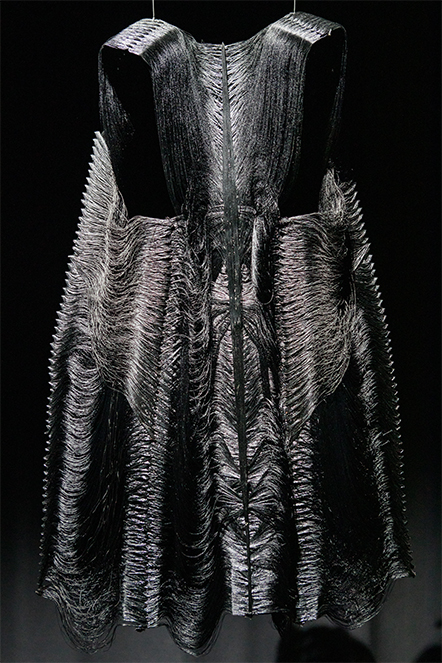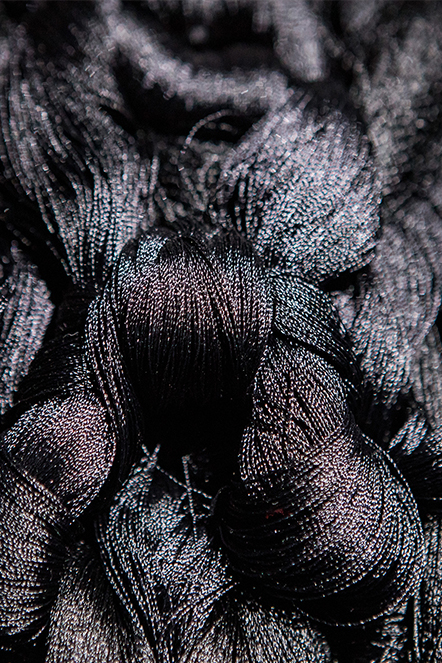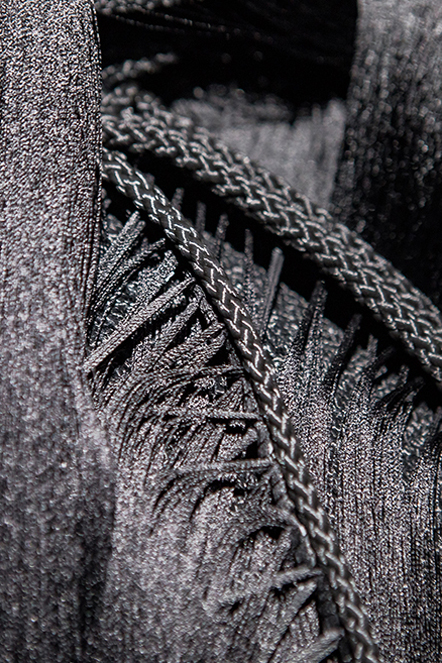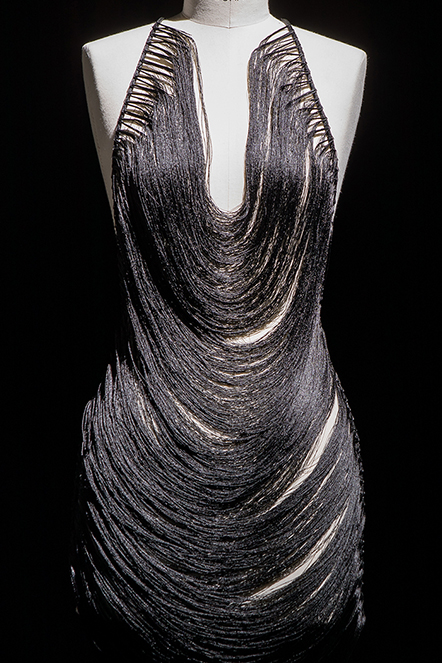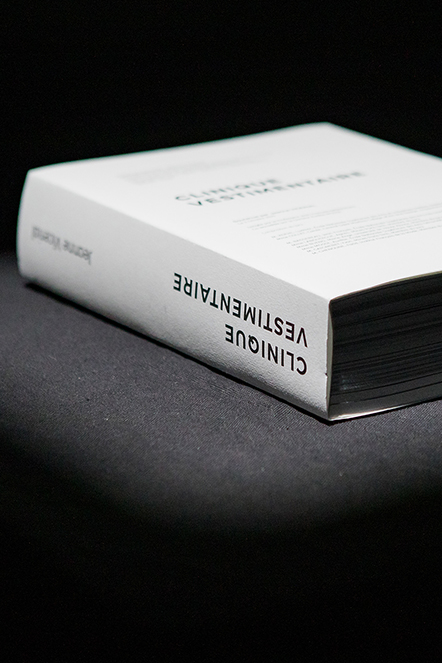clinique vestimentaire
for a new paradigm of creation & custom-made clothing design
about this contribution
Today, the two techniques for designing and making clothes are generally opposed to each other: made-to-measure and ready-to-wear. While the latter imposes a size category and requires the individual to adapt, the former is adapted to the person. The research involved in Jeanne Vicerial’s Clinique vestimentaire merges the two approaches, converging to form new systems for the design and making of clothes, creating a new paradigm: “ready-to-measure.” This model combines the speed of ready-to-wear with the unique, specific nature of made-to-measure, in which the clothing-object is connected to the body of the person who wears it.
This system of designing and making clothes is based on a new approach to composing thread, partly “bio-inspired”: tricotissage, or “knitting-weaving,” between knitting—a single thread—and weaving, which enables the creation of a textile, assembled in a similar way to human muscular tissue.
In collaboration with the mechatronics department at MINES ParisTech – PSL, led by Yvon Gaignebet, the Clinique vestimentaire research project has developed a prototype knitting-weaving machine. A tool for creation and production, the unit is a computer-driven mechanical system for knitting-weaving made-to measure clothing at a semi-industrial scale with no waste.
Dialogue begins with the first encounter with the customer for taking measurements, through verbal communication (consciously expressed desires and sensations) but also non-verbal communication (postures and behavior). Measures that take into account not only anatomical considerations but also anthropological, physiological, and psycho-sociological elements. The production of the garment by the knitting-weaving table is then done according to the body’s dimensions translated and interpreted digitally and electronically. During the production process, manual interactions remain possible for adjustments; the machine is also a tool and leaves room for interventions, reviving the classic interactions of the craft. A digital craft with the ultimate goal of designing a custom garment, without remnants, with a know-how focused on the precision of the “cut” and assembly, and delivering personalized clothing with and for the customer.
More recently, Sculptures vestimentaires continues this research, aiming to give women their place and voice with regards to fashion, norms, and sizing. More recently, Quarantaine is a formal and visual response to the health crisis, at a time when closing and distancing are the order of the day. A work is being created every day for 40 days using the only body available—the confined body of its author.
credits
author: Jeanne Vicerial, designer and SACRe Design PhD, École des Arts Décoratifs, Paris – PSL
Research & Creation project carried out at EnsadLab (thesis supervision by Prof. Jean-François Bassereau and Dr. Aurélie Mosse), in collaboration with the mechatronics department of MINES ParisTech – PSL directed by Yvon Gaignebet
editorial mediation: Gwenaëlle Lallemand
graphic designer: Arp is Arp Studio (Dimitri Charrel)
photo credits: see below
sponsors: this contribution is supported by the Chaire Beauté.s PSL
translation: Monique Gross
copy editing: Bronwyn Mahoney
rights and references
illustrations rights and references
read more read less
Copyright: Photos reproduced with permission from the author in 2022.
Jeanne Vicerial, Clinique vestimentaire, 2015. © Béryl Libault de la Chevasnerie, École des Arts Décoratifs
Jeanne Vicerial, Clinique Vestimentaire, 2017. © Vivien Bertin
Jeanne Vicerial, Details of the tricotissage, Clinique Vestimentaire, 2016. © Clara Giaminardi for Bullet Magazine
András Szunyoghy, Le Grand Cours d’anatomie artistique, 2000. Drawings. © Adagp, Paris, 2022. © Ullmann Medien GmbH. Rolandsecker Weg 30, 53619 Rheinbreitbach, Germany. All rights reserved.
Jeanne Vicerial, Pattern of the dorsal muscle tissue reproduced in thread by means of tricotissage and affixed to the image above. © Adagp, Paris, 2022. © Ullmann Medien GmbH, Rolandsecker Weg 30, 53619 Rheinbreitbach, Germany.
Jeanne Vicerial, collection Lignes Noires in collaboration with Jennifer Chambaret, Clinique Vestimentaire, 2017. © Vivien Bertin
Jeanne Vicerial, Clinique Vestimentaire, 2015. © Marie-Elodie Fallourd, École des Arts Décoratifs
Jeanne Vicerial, 155km long thread dress, Clinique Vestimentaire, 2015. © Thibaut Della Gaspera
Jeanne Vicerial, Clinique Vestimentaire, 2015. © Maxime Imbert, École des Arts Décoratifs
Jeanne Vicerial, Clinique Vestimentaire, 2015. © Maxime Imbert.
Graphic design: Arp is Arp Studio (Dimitri Charrel)
Jeanne Vicerial, Clinique Vestimentaire, 2019. © Mathieu Faluomi.
Graphic design: Arp is Arp Studio (Dimitri Charrel)
Jeanne Vicerial, Clinique Vestimentaire, 2019. © Joseph Schiano di Lombo
Jeanne Vicerial, Clinique Vestimentaire, 2019. © Aleksandr Kontini
bibliography and references
read more read less
Acuna, Diego. 2004. Méthodes scientifiques de conception de produit, approche franco-américaine. Paris : PhD Thesis ENSAM.
Alberti Leon-Battista, Pierre Caye and Françoise Choay. 2010. L’art d’édifier. Paris: Seuil.
Anzieu Didier. 1985. Le Moi-Peau. Paris: Dunod.
Archer, Bruce, Ken Baynes and Phil Roberts. 1992. The nature of research into Design and Technology education. Loughborough: Loughborough University.
Arnold, Janet. 1966. Patterns of Fashion 2. 2e ed. 1997. London: Macmillan London limited.
Article of the Danish Fashion institute, 2017. Pulse of the Fashion industry.
Barde, F.A. 1834. Traité encyclopédique de l’art du tailleur. pp. 73-74 ; Section Deuxième, Des instruments nécessaires pour bien prendre les mesures. pp. 73.
Barthes, Roland. 1967. Système de la mode. Chap1.1. Ed 2014. Paris: Seuil.
Barthes, Roland. Encore le corps, Œuvres Complètes V, pp. 561-62. Paris: Seuil.
Bassereau, Jean-François. forthcoming. L’essence des matériaux. Paris: Edition des Mines.
Bassereau, Jean-François. 2013. Design sensoriel, une recherche interdisciplinaire en action/recherche, p.141. Tours: HdR, UFR de Tours.
Belfanti, Carlo Marco. 2008. Civilta della mode. Bologne: Il Mulino.
Belfanti, Carlo Marco. 2008. Histoire culturelle de la mode. French edition, 2017, pp.249. Paris: IFM/regard.
Birglen, Lionel. 2016. Mécatronique : Cours et exercices corrigés, p.416. Malakoff: Dunod.
Black, Sandy. 2012. The Sustainable fashion handbook. London: Thames and Hudson.
Black, Sandy. 2008. Eco-chic: the fashion paradox. London: BlackDog Publishing.
Boucher, François and Yvonne Deslandres. 2008. Histoire du costume en Occident : Des origines à nos jours, p. 40. Paris: Flammarion.
Bourdieu, Pierre and Yvette Delsaut. 1975. “Le couturier et sa griffe : contribution à une théorie de la magie”. Actes de la Recherche en sciences Sociales 1, no.1, pp. 7-36.
Brossard, Michel. 1998. “Assis ou debout ? Réflexions sur l’implantation de l’organisation modulaire de travail dans le vêtement”. Relations industrielles / Industrial Relations, vol. 53, no. 3, summer 1998, p. 403-429.
Bruna, Denis. 2013. La Mécanique des Dessous Une Histoire indiscrète de la silhouette, pp. 21-22. Paris: Les Arts Décoratifs.
Caves, Richard. 2000. Creative industries: Contracts between Art and Commerce. Cambridge/London: Harvard University Press.
Chapman, Jonathan. 2005. Emotionally durable design: objects, experiences and empathy. pp. 40-42. London: Earthscan.
Charter, Martin. 2019. Designing for the Circular Economy. London: Routledge.
Collet, Carole. 2012. “Biolace: An exploration of the potential of synthetic biology and liing technology for future textiles”. Studies in material Thinking. vol. 7.
Deleuze, Gilles and Félix Guattari. 1980. Capitalisme et schizophrénie 2, Mille plateaux, p. 549. Paris: Éditions de Minuit.
Ibid., pp. 594-595.
Deforge Yves. 1989. L’œuvre et le produit. Paris: Champ Villon.
Detrez, Christine. 2002. La construction sociale du corps, pp. 76-77. Paris: Seuil.
Eberle, Hannelore, Hermann Hermeling, Marianne Hornberger and Dieter Menzer. 2012. La Technologie du vêtement. Paris: Éditions Guérin.
Findeli, Alain. 2008. As an introduction during Ateliers de la Recherche en Design, Nîmes.
Fletcher Kate and Lynda Grose. 2012. Fashion & Sustainability, Design for change. London: Laurence King.
Fletcher, Kate. 2008. Sustainable Fashion and Textiles: design journeys, pp. 98-99. London: Earthscan.
Franklin, Kate. 2018. Radical Matters: rethinking materials for sustainable future. London: Thames & Hudson.
Frayling, Christopher. 1993/4. “Research in art and design”. Royal College of Art Research Papers, vol. 1, no. 1, pp. 1-5.
Gautrand, Pascal. 2012. L’artisanat, la main et l’industrialisation. Paris: IFM Mode de recherche n° 18.
Godart, Frédéric. 2010. Sociologie de la mode. Paris: La Découverte.
Grau, François-Marie. 1998. Histoire du costume. Paris: Puf.
Gray, Carole and Julian Malins. 2004. Visualizing research: A guide to the Research Process in Art and Design. Abingdon, Oxon: Asgate, e-Book.
Grumbach, Didier. 2008. Histoires de la mode. Paris: Éditions du Regard.
Hagene Bernard and Pierre Saliot. 1995. Mesures & Démesure. Paris: Les éditions de la Cité des sciences et de l’industrie.
Hegel, Georg Wilhelm Friedrich. 1944. Esthétique, p.147. Paris: Aubier, III, 1ère partie.
Ingold, Tim. 2018. Faire anthropologie, art et archéologie, p. 108. Bellevaux: Dehors.
Ibid., p. 263.
Ingold, Tim. 2013. “The Materials of life”, Making, Anthroplogy, Archeology, Art and Architecture. London: Routledge.
Kandinsky, Vassily. 1926. Point et ligne sur plan. Ed.1991. Paris: Gallimard.
Laski, Gary. 2011. Le design : Théorie esthétique de l’histoire industrielle, Philosophy thesis. Paris: Université Paris-Est.
Le Corbusier, 1924. Urbanisme. Ed.1994, p. 10. Paris: Flammarion.
Leroi-Gourhan, André. 1945. Milieu et technique. Ed.1975. Paris: Albin Michel.
Levy Strauss, Claude. 1955. Tristes tropiques. Ed. 2001, pp. 347-360. Paris: Pocket.
Morin, Edgar. 2004. “Éthique”. La méthode 6, p. 65. Paris: Seuil.
Mosse, Aurélie. 2014. Gossamer Timescapes: Designing self-actuated textiles for the home. Danemark: The Royal Danish Academy of Fine Arts, Schools of Architecture, Design and Conservation, pp. 74-79.
Ibid., pp. 219-220.
Mosse, Aurélie and Jean-François Bassereau. 2019. “Soft Matters : en quête d’une pratique du design textile et matière plus résiliente”. Sciences du design, no. 9 p. 53.
Naylor Maxine and Ralph Ball R. 2005. Form Follows Idea: An Introduction to Design Poetics: pp. 26-27. London: Black Dog.
Ormen, Catherine. 2009. Histoire(s) du prêt-à-porter. Paris: IFM.
Prost, Robert. 1995. Concevoir, inventer, créer. Paris: Autrement.
Quinn, Bradley. 2010. Textiles futures, fashion, design and technology, pp. 53-55. Oxford: Berg.
Sèze, Claudette. 1990. Confort moderne, une nouvelle culture du bien-être. Paris: Autrement.
Sherwood, James. 2010. Savile Row : Les maître tailleurs du sur-mesure Britannique. Paris : L’Edit.
Simmel, Guido.1904. Philosophie de la mode. Ed. 2015. Paris: Allia. First publication: 2015. Source: Bibliothèque nationale de France, departement: Sciences et techniques, 4 V 1180.
Vergani, Guido. 1992. La renaissance de la Mode Italienne Florence, la Sala Bianca, 1952-1973. French edition, 1993. Milan: Electa.
Waugh, Norah. 1968. The Cut of Women’s Clothes 1600-1930. London: Faber and faber limited.
Waugh, Norah. 1968. Corset and Crinolines. London: Faber and faber limited.
Waugh, Norah. 1968. The Cut of Men’s Clothes: 1600-1900. London: Faber and faber limited.
Zacklad, Manuel. 2017. Design, conception, création. Vers une théorie interdisciplinaire du Design. Paris: Conservatoire national des Arts et Métiers – Équipe Innovation. Published November 07, 2017.
to cite this article
This article is using Chicago format for its references
Vicerial, Jeanne. 2023. “Clinique Vestimentaire: for a New Paradigm of Creation & Custom-Made Clothing Design.” .able journal: https://able-journal.org/clinique-vestimentaire
cite this article
MLA
EN
Vicerial, Jeanne. “Clinique Vestimentaire: for a New Paradigm of Creation & Custom-Made Clothing Design.” .able journal, 2023. https://able-journal.org/clinique-vestimentaire
ISO 690
EN
VICERIAL, Jeanne. Clinique Vestimentaire: for a New Paradigm of Creation & Custom-Made Clothing Design. .able journal [online]. 2023. Available from: https://able-journal.org/clinique-vestimentaire
APA
EN
Vicerial, J. (2023). Clinique Vestimentaire: for a New Paradigm of Creation & Custom-Made Clothing Design. .able journal. https://able-journal.org/clinique-vestimentaire
print this contribution
Use the links below to print this contribution. You have the choice between a high-quality format or an eco-quality format optimized to reduce environmental impact.






